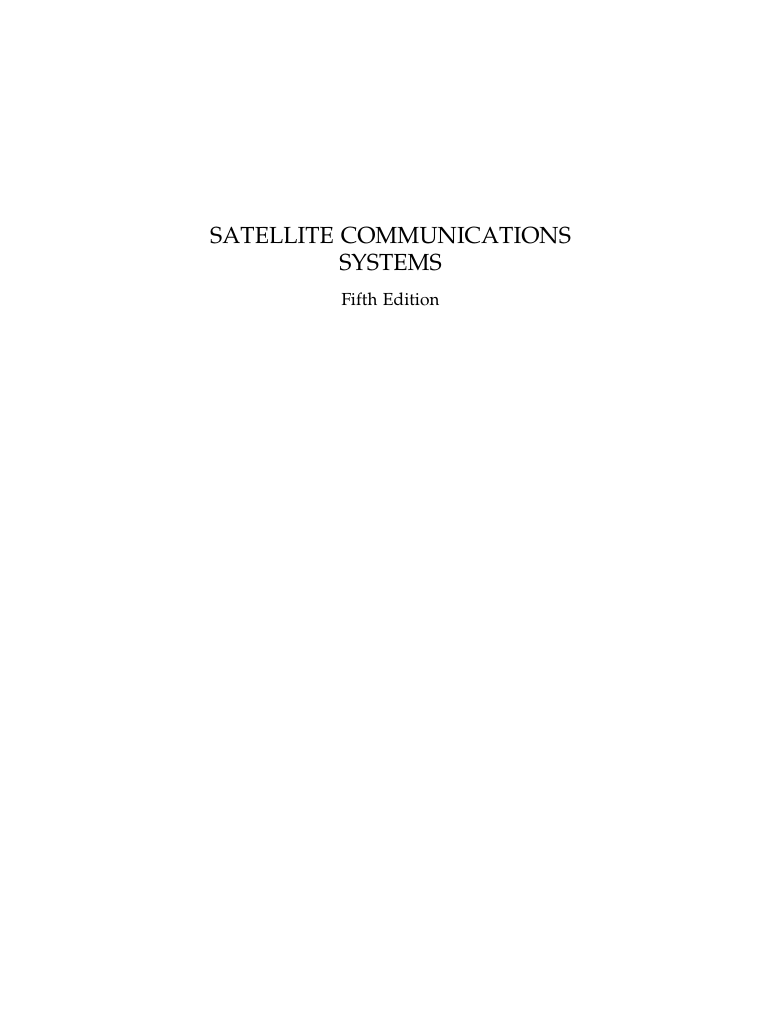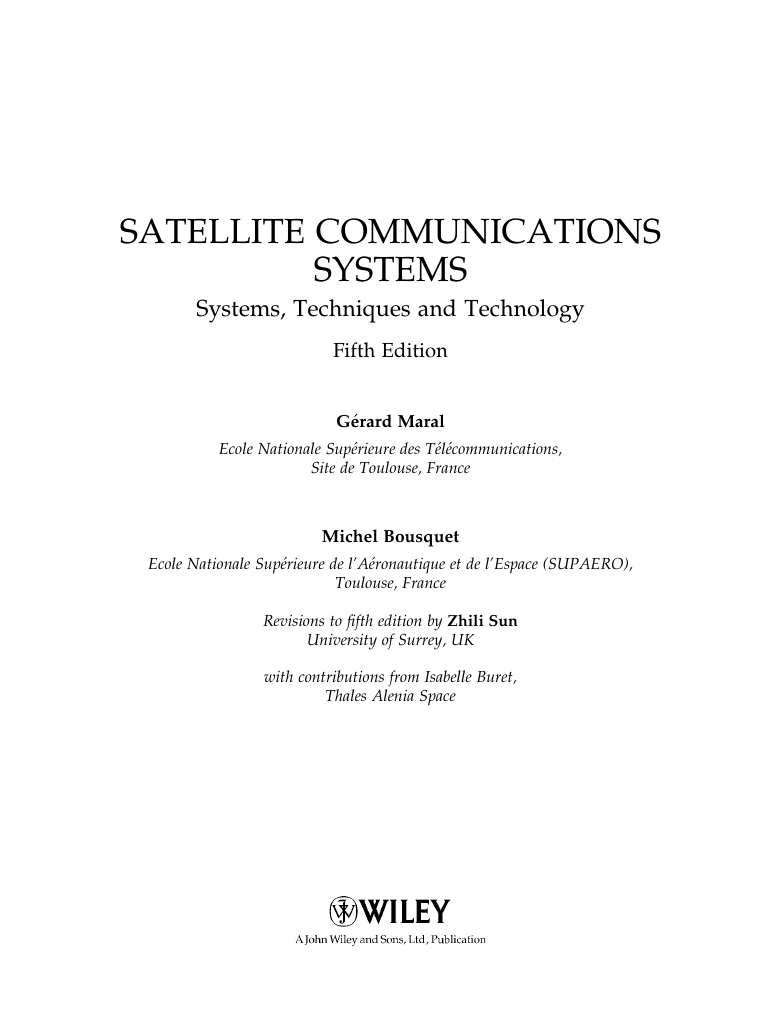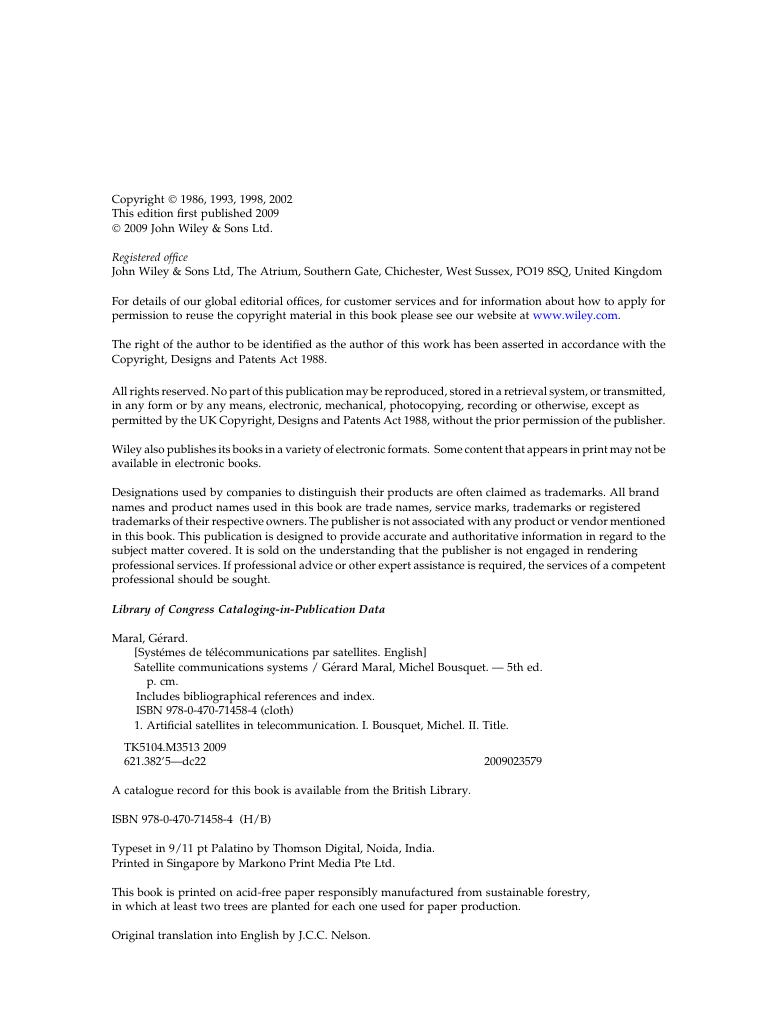SATELLITE COMMUNICATIONS SYSTEMS: Systems, Techniques and Technology
CONTENTS
ACKNOWLEDGEMENT
ACRONYMS
NOTATION
1 INTRODUCTION
1.1 BIRTH OF SATELLITE COMMUNICATIONS
1.2 DEVELOPMENT OF SATELLITE COMMUNICATIONS
1.3 CONFIGURATION OF A SATELLITE COMMUNICATIONS SYSTEM
1.3.1 Communications links
1.3.2 The space segment
1.3.3 The ground segment
1.4 TYPES OF ORBIT
1.5 RADIO REGULATIONS
1.5.1 The ITU organisation
1.5.2 Space radiocommunications services
1.5.3 Frequency allocation
1.6 TECHNOLOGY TRENDS
1.7 SERVICES
1.8 THE WAY FORWARD
REFERENCES
2 ORBITS AND RELATED ISSUES
2.1 KEPLERIAN ORBITS
2.1.1 Kepler’s laws
2.1.2 Newton’s law
2.1.3 Relative movement of two point bodies
2.1.4 Orbital parameters
2.1.5 The earth’s orbit
2.1.6 Earth–satellite geometry
2.1.7 Eclipses of the sun
2.1.8 Sun–satellite conjunction
2.2 USEFUL ORBITS FOR SATELLITE COMMUNICATION
2.2.1 Elliptical orbits with non-zero inclination
2.2.2 Geosynchronous elliptic orbits with zero inclination
2.2.3 Geosynchronous circular orbits with non-zero inclination
2.2.4 Sub-synchronous circular orbits with zero inclination
2.2.5 Geostationary satellite orbits
2.3 PERTURBATIONS OF ORBITS
2.3.1 The nature of perturbations
2.3.2 The effect of perturbations; orbit perturbation
2.3.3 Perturbations of the orbit of geostationary satellites
2.3.4 Orbit corrections: station keeping of geostationary satellites
2.4 CONCLUSION
REFERENCES
3 BASEBAND SIGNALS AND QUALITY OF SERVICE
3.1 BASEBAND SIGNALS
3.1.1 Digital telephone signal
3.1.2 Sound signals
3.1.3 Television signals
3.1.4 Data and multimedia signals
3.2 PERFORMANCE OBJECTIVES
3.2.1 Telephone
3.2.2 Sound
3.2.3 Television
3.2.4 Data
3.3 AVAILABILITY OBJECTIVES
3.4 DELAY
3.4.1 Delay in terrestrial network
3.4.2 Propagation delay over satellite links
3.4.3 Baseband-signal processing time
3.4.4 Protocol-induced delay
3.5 CONCLUSION
REFERENCES
4 DIGITAL COMMUNICATIONS TECHNIQUES
4.1 BASEBAND FORMATTING
4.1.1 Encryption
4.1.2 Scrambling
4.2 DIGITAL MODULATION
4.2.1 Two-state modulation—BPSK and DE-BPSK
4.2.2 Four-state modulation—QPSK
4.2.3 Variants of QPSK
4.2.4 Higher-order PSK and APSK
4.2.5 Spectrum of unfiltered modulated carriers
4.2.6 Demodulation
4.2.7 Modulation spectral efficiency
4.3 CHANNEL CODING
4.3.1 Block encoding and convolutional encoding
4.3.2 Channel decoding
4.3.3 Concatenated encoding
4.3.4 Interleaving
4.4 CHANNEL CODING AND THE POWER–BANDWIDTH TRADE-OFF
4.4.1 Coding with variable bandwidth
4.4.2 Coding with constant bandwidth
4.4.3 Example: Downlink coding with on-board regeneration
4.4.4 Conclusion
4.5 CODED MODULATION
4.5.1 Trellis coded modulation
4.5.2 Block coded modulation
4.5.3 Decoding coded modulation
4.5.4 Multilevel trellis coded modulation
4.5.5 TCM using a multidimensional signal set
4.5.6 Performance of coded modulations
4.6 END-TO-END ERROR CONTROL
4.7 DIGITAL VIDEO BROADCASTING VIA SATELLITE (DVB-S)
4.7.1 Transmission system
4.7.2 Error performance requirements
4.8 SECOND GENERATION DVB-S
4.8.1 New technology in DVB-S2
4.8.2 Transmission system architecture
4.8.3 Error performance
4.9 CONCLUSION
4.9.1 Digital transmission of telephony
4.9.2 Digital broadcasting of television
REFERENCES
5 UPLINK, DOWNLINK AND OVERALL LINK PERFORMANCE; INTERSATELLITE LINKS
5.1 CONFIGURATION OF A LINK
5.2 ANTENNA PARAMETERS
5.2.1 Gain
5.2.2 Radiation pattern and angular beamwidth
5.2.3 Polarisation
5.3 RADIATED POWER
5.3.1 Effective isotropic radiated power (EIRP)
5.3.2 Power flux density
5.4 RECEIVED SIGNAL POWER
5.4.1 Power captured by the receiving antenna and free space loss
5.4.2 Example 1: Uplink received power
5.4.3 Example 2: Downlink received power
5.4.4 Additional losses
5.4.5 Conclusion
5.5 NOISE POWER SPECTRAL DENSITY AT THE RECEIVER INPUT
5.5.1 The origins of noise
5.5.2 Noise characterisation
5.5.3 Noise temperature of an antenna
5.5.4 System noise temperature
5.5.5 System noise temperature: Example
5.5.6 Conclusion
5.6 INDIVIDUAL LINK PERFORMANCE
5.6.1 Carrier power to noise power spectral density ratio at receiver input
5.6.2 Clear sky uplink performance
5.6.3 Clear sky downlink performance
5.7 INFLUENCE OF THE ATMOSPHERE
5.7.1 Impairments caused by rain
5.7.2 Other impairments
5.7.3 Link impairments—relative importance
5.7.4 Link performance under rain conditions
5.7.5 Conclusion
5.8 MITIGATION OF ATMOSPHERIC IMPAIRMENTS
5.8.1 Depolarisation mitigation
5.8.2 Attenuation mitigation
5.8.3 Site diversity
5.8.4 Adaptivity
5.8.5 Cost–availability trade-off
5.9 OVERALL LINK PERFORMANCE WITH TRANSPARENT SATELLITE
5.9.1 Characteristics of the satellite channel
5.9.2 Expression for (C/N0)
5.9.3 Overall link performance for a transparent satellite without interference or intermodulation
5.10 OVERALL LINK PERFORMANCE WITH REGENERATIVE SATELLITE
5.10.1 Linear satellite channel without interference
5.10.2 Non-linear satellite channel without interference
5.10.3 Non-linear satellite channel with interference
5.11 LINK PERFORMANCE WITH MULTIBEAM ANTENNA COVERAGE VS MONOBEAM COVERAGE
5.11.1 Advantages of multibeam coverage
5.11.2 Disadvantages of multibeam coverage
5.11.3 Conclusion
5.12 INTERSATELLITE LINK PERFORMANCE
5.12.1 Frequency bands
5.12.2 Radio-frequency links
5.12.3 Optical links
5.12.4 Conclusion
REFERENCES
6 MULTIPLE ACCESS
6.1 LAYERED DATA TRANSMISSION
6.2 TRAFFIC PARAMETERS
6.2.1 Traffic intensity
6.2.2 Call blocking probability
6.2.3 Burstiness
6.3 TRAFFIC ROUTING
6.3.1 One carrier per station-to-station link
6.3.2 One carrier per transmitting station
6.3.3 Comparison
6.4 ACCESS TECHNIQUES
6.4.1 Access to a particular satellite channel (or transponder)
6.4.2 Multiple access to the satellite channel
6.4.3 Performance evaluation—efficiency
6.5 FREQUENCY DIVISION MULTIPLE ACCESS (FDMA)
6.5.1 TDM/PSK/FDMA
6.5.2 SCPC/FDMA
6.5.3 Adjacent channel interference
6.5.4 Intermodulation
6.5.5 FDMA efficiency
6.5.6 Conclusion
6.6 TIME DIVISION MULTIPLE ACCESS (TDMA)
6.6.1 Burst generation
6.6.2 Frame structure
6.6.3 Burst Reception
6.6.4 Synchronisation
6.6.5 TDMA efficiency
6.6.6 Conclusion
6.7 CODE DIVISION MULTIPLE ACCESS (CDMA)
6.7.1 Direct sequence (DS-CDMA)
6.7.2 Frequency hopping CDMA (FH-CDMA)
6.7.3 Code generation
6.7.4 Synchronisation
6.7.5 CDMA efficiency
6.7.6 Conclusion
6.8 FIXED AND ON-DEMAND ASSIGNMENT
6.8.1 The principle
6.8.2 Comparison between fixed and on-demand assignment
6.8.3 Centralised or distributed management of on-demand assignment
6.8.4 Conclusion
6.9 RANDOM ACCESS
6.9.1 Asynchronous protocols
6.9.2 Protocols with synchronisation
6.9.3 Protocols with assignment on demand
6.10 CONCLUSION
REFERENCES
7 SATELLITE NETWORKS
7.1 NETWORK REFERENCE MODELS AND PROTOCOLS
7.1.1 Layering principle
7.1.2 Open Systems Interconnection (OSI) reference model
7.1.3 IP reference model
7.2 REFERENCE ARCHITECTURE FOR SATELLITE NETWORKS
7.3 BASIC CHARACTERISTICS OF SATELLITE NETWORKS
7.3.1 Satellite network topology
7.3.2 Types of link
7.3.3 Connectivity
7.4 SATELLITE ON-BOARD CONNECTIVITY
7.4.1 On-board connectivity with transponder hopping
7.4.2 On-board connectivity with transparent processing
7.4.3 On-board connectivity with regenerative processing
7.4.4 On-board connectivity with beam scanning
7.5 CONNECTIVITY THROUGH INTERSATELLITE LINKS (ISL)
7.5.1 Links between geostationary and low earth orbit satellites (GEO–LEO)
7.5.2 Links between geostationary satellites (GEO–GEO)
7.5.3 Links between low earth orbit satellites (LEO–LEO)
7.5.4 Conclusion
7.6 SATELLITE BROADCAST NETWORKS
7.6.1 Single uplink (one programme) per satellite channel
7.6.2 Several programmes per satellite channel
7.6.3 Single uplink with time division multiplex (TDM) of programmes
7.6.4 Multiple uplinks with time division multiplex (TDM) of programmes on downlink
7.7 BROADBAND SATELLITE NETWORKS
7.7.1 Overview of DVB-RCS and DVB-S/S2 network
7.7.2 Protocol stack architecture for broadband satellite networks
7.7.3 Physical layer
7.7.4 Satellite MAC layer
7.7.5 Satellite link control layer
7.7.6 Quality of service
7.7.7 Network layer
7.7.8 Regenerative satellite mesh network architecture
7.8 TRANSMISSION CONTROL PROTOCOL
7.8.1 TCP segment header format
7.8.2 Connection set up and data transmission
7.8.3 Congestion control and flow control
7.8.4 Impact of satellite channel characteristics on TCP
7.8.5 TCP performance enhancement
7.9 IPv6 OVER SATELLITE NETWORKS
7.9.1 IPv6 basics
7.9.2 IPv6 transitions
7.9.3 IPv6 tunnelling through satellite networks
7.9.4 6to4 translation via satellite networks
7.10 CONCLUSION
REFERENCES
8 EARTH STATIONS
8.1 STATION ORGANISATION
8.2 RADIO-FREQUENCY CHARACTERISTICS
8.2.1 Effective isotropic radiated power (EIRP)
8.2.2 Figure of merit of the station
8.2.3 Standards defined by international organisations and satellite operators
8.3 THE ANTENNA SUBSYSTEM
8.3.1 Radiation characteristics (main lobe)
8.3.2 Side-lobe radiation
8.3.3 Antenna noise temperature
8.3.4 Types of antenna
8.3.5 Pointing angles of an earth station antenna
8.3.6 Mountings to permit antenna pointing
8.3.7 Tracking
8.4 THE RADIO-FREQUENCY SUBSYSTEM
8.4.1 Receiving equipment
8.4.2 Transmission equipment
8.4.3 Redundancy
8.5 COMMUNICATION SUBSYSTEMS
8.5.1 Frequency translation
8.5.2 Amplification, filtering and equalisation
8.5.3 Modems
8.6 THE NETWORK INTERFACE SUBSYSTEM
8.6.1 Multiplexing and demultiplexing
8.6.2 Digital speech interpolation (DSI)
8.6.3 Digital circuit multiplication equipment (DCME)
8.6.4 Echo suppression and cancellation
8.6.5 Equipment specific to SCPC transmission
8.7 MONITORING AND CONTROL; AUXILIARY EQUIPMENT
8.7.1 Monitoring, alarms and control (MAC) equipment
8.7.2 Electrical power
8.8 CONCLUSION
REFERENCES
9 THE COMMUNICATION PAYLOAD
9.1 MISSION AND CHARACTERISTICS OF THE PAYLOAD
9.1.1 Functions of the payload
9.1.2 Characterisation of the payload
9.1.3 The relationship between the radio-frequency characteristics
9.2 TRANSPARENT REPEATER
9.2.1 Characterisation of non-linearities
9.2.2 Repeater organisation
9.2.3 Equipment characteristics
9.3 REGENERATIVE REPEATER
9.3.1 Coherent demodulation
9.3.2 Differential demodulation
9.3.3 Multicarrier demodulation
9.4 MULTIBEAM ANTENNA PAYLOAD
9.4.1 Fixed interconnection
9.4.2 Reconfigurable (semi-fixed) interconnection
9.4.3 Transparent on-board time domain switching
9.4.4 On-board frequency domain transparent switching
9.4.5 Baseband regenerative switching
9.4.6 Optical switching
9.5 INTRODUCTION TO FLEXIBLE PAYLOADS
9.6 SOLID STATE EQUIPMENT TECHNOLOGY
9.6.1 The environment
9.6.2 Analogue microwave component technology
9.6.3 Digital component technology
9.7 ANTENNA COVERAGE
9.7.1 Service zone contour
9.7.2 Geometrical contour
9.7.3 Global coverage
9.7.4 Reduced or spot coverage
9.7.5 Evaluation of antenna pointing error
9.7.6 Conclusion
9.8 ANTENNA CHARACTERISTICS
9.8.1 Antenna functions
9.8.2 The radio-frequency coverage
9.8.3 Circular beams
9.8.4 Elliptical beams
9.8.5 The influence of depointing
9.8.6 Shaped beams
9.8.7 Multiple beams
9.8.8 Types of antenna
9.8.9 Antenna technologies
9.9 CONCLUSION
REFERENCES
10 THE PLATFORM
10.1 SUBSYSTEMS
10.2 ATTITUDE CONTROL
10.2.1 Attitude control functions
10.2.2 Attitude sensors
10.2.3 Attitude determination
10.2.4 Actuators
10.2.5 The principle of gyroscopic stabilisation
10.2.6 Spin stabilisation
10.2.7 ‘Three-axis’ stabilisation
10.3 THE PROPULSION SUBSYSTEM
10.3.1 Characteristics of thrusters
10.3.2 Chemical propulsion
10.3.3 Electric propulsion
10.3.4 Organisation of the propulsion subsystem
10.3.5 Electric propulsion for station keeping and orbit transfer
10.4 THE ELECTRIC POWER SUPPLY
10.4.1 Primary energy sources
10.4.2 Secondary energy sources
10.4.3 Conditioning and protection circuits
10.4.4 Example calculations
10.5 TELEMETRY, TRACKING AND COMMAND (TTC) AND ON-BOARD DATA HANDLING (OBDH)
10.5.1 Frequencies used
10.5.2 The telecommand links
10.5.3 Telemetry links
10.5.4 Telecommand (TC) and telemetry (TM) message format standards
10.5.5 On-board data handling (OBDH)
10.5.6 Tracking
10.6 THERMAL CONTROL AND STRUCTURE
10.6.1 Thermal control specifications
10.6.2 Passive control
10.6.3 Active control
10.6.4 Structure
10.6.5 Conclusion
10.7 DEVELOPMENTS AND TRENDS
REFERENCES
11 SATELLITE INSTALLATION AND LAUNCH VEHICLES
11.1 INSTALLATION IN ORBIT
11.1.1 Basic principles
11.1.2 Calculation of the required velocity increments
11.1.3 Inclination correction and circularisation
11.1.4 The apogee (or perigee) motor
11.1.5 Injection into orbit with a conventional launcher
11.1.6 Injection into orbit from a quasi-circular low altitude orbit
11.1.7 Operations during installation (station acquisition)
11.1.8 Injection into orbits other than geostationary
11.1.9 The launch window
11.2 LAUNCH VEHICLES
11.2.1 Brazil
11.2.2 China
11.2.3 Commonwealth of Independent States (CIS)
11.2.4 Europe
11.2.5 India
11.2.6 Israel
11.2.7 Japan
11.2.8 South Korea
11.2.9 United States of America
11.2.10 Reusable launch vehicles
11.2.11 Cost of installation in orbit
REFERENCES
12 THE SPACE ENVIRONMENT
12.1 VACUUM
12.1.1 Characterisation
12.1.2 Effects
12.2 THE MECHANICAL ENVIRONMENT
12.2.1 The gravitational field
12.2.2 The earth’s magnetic field
12.2.3 Solar radiation pressure
12.2.4 Meteorites and material particles
12.2.5 Torques of internal origin
12.2.6 The effect of communication transmissions
12.2.7 Conclusions
12.3 RADIATION
12.3.1 Solar radiation
12.3.2 Earth radiation
12.3.3 Thermal effects
12.3.4 Effects on materials
12.4 FLUX OF HIGH ENERGY PARTICLES
12.4.1 Cosmic particles
12.4.2 Effects on materials
12.5 THE ENVIRONMENT DURING INSTALLATION
12.5.1 The environment during launching
12.5.2 Environment in the transfer orbit
REFERENCES
13 RELIABILITY OF SATELLITE COMMUNICATIONS SYSTEMS
13.1 INTRODUCTION OF RELIABILITY
13.1.1 Failure rate
13.1.2 The probability of survival or reliability
13.1.3 Failure probability or unreliability
13.1.4 Mean time to failure (MTTF)
13.1.5 Mean satellite lifetime
13.1.6 Reliability during the wear-out period
13.2 SATELLITE SYSTEM AVAILABILITY
13.2.1 No back-up satellite in orbit
13.2.2 Back-up satellite in orbit
13.2.3 Conclusion
13.3 SUBSYSTEM RELIABILITY
13.3.1 Elements in series
13.3.2 Elements in parallel (static redundancy)
13.3.3 Dynamic redundancy (with switching)
13.3.4 Equipment having several failure modes
13.4 COMPONENT RELIABILITY
13.4.1 Component reliability
13.4.2 Component selection
13.4.3 Manufacture
13.4.4 Quality assurance
INDEX
















 2023年江西萍乡中考道德与法治真题及答案.doc
2023年江西萍乡中考道德与法治真题及答案.doc 2012年重庆南川中考生物真题及答案.doc
2012年重庆南川中考生物真题及答案.doc 2013年江西师范大学地理学综合及文艺理论基础考研真题.doc
2013年江西师范大学地理学综合及文艺理论基础考研真题.doc 2020年四川甘孜小升初语文真题及答案I卷.doc
2020年四川甘孜小升初语文真题及答案I卷.doc 2020年注册岩土工程师专业基础考试真题及答案.doc
2020年注册岩土工程师专业基础考试真题及答案.doc 2023-2024学年福建省厦门市九年级上学期数学月考试题及答案.doc
2023-2024学年福建省厦门市九年级上学期数学月考试题及答案.doc 2021-2022学年辽宁省沈阳市大东区九年级上学期语文期末试题及答案.doc
2021-2022学年辽宁省沈阳市大东区九年级上学期语文期末试题及答案.doc 2022-2023学年北京东城区初三第一学期物理期末试卷及答案.doc
2022-2023学年北京东城区初三第一学期物理期末试卷及答案.doc 2018上半年江西教师资格初中地理学科知识与教学能力真题及答案.doc
2018上半年江西教师资格初中地理学科知识与教学能力真题及答案.doc 2012年河北国家公务员申论考试真题及答案-省级.doc
2012年河北国家公务员申论考试真题及答案-省级.doc 2020-2021学年江苏省扬州市江都区邵樊片九年级上学期数学第一次质量检测试题及答案.doc
2020-2021学年江苏省扬州市江都区邵樊片九年级上学期数学第一次质量检测试题及答案.doc 2022下半年黑龙江教师资格证中学综合素质真题及答案.doc
2022下半年黑龙江教师资格证中学综合素质真题及答案.doc